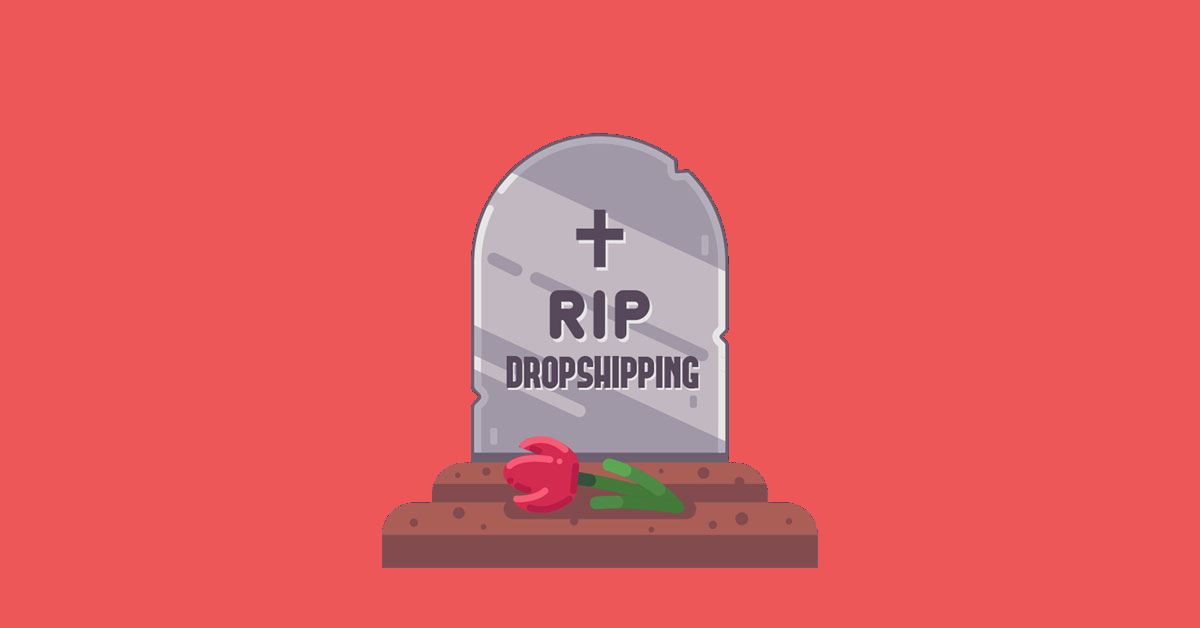Why Dropshipping Is On The Brink Of Death (2022 Update)

It seems that a hundred new Shopify dropshipping stores are popping out every day.
First, let’s take a look at a typical dropshipping store.
Besides a sketchy-looking Shopify store and generic Aliexpress products, they didn’t even bother to write proper product descriptions but rather just copy/pasted everything from Aliexpress.
Chinese watermarks on product images that are 150×125 pixels? Good enough.
Now, even that’s too much work for an average dropshipping Joe and now there are Shopify apps that automatically generate text for all your product pages so you don’t have to do almost any work! He thinks to himself: “I like this dropshipping business model better every day!”
He then goes ahead and tests dozens of products on Facebook ads, day in and day out…
Praying to Jack Ma and Zuckerberg that he will build a dropshipping empire as he saw in the YouTube ad where a guy was promoting a webinar from a Lamborghini on how to EASILY make at least $500/day profit in the first month of dropshipping with no experience & no investment whatsoever.
Let’s say that he’s one of the few people that gets lucky and actually makes a decent number of sales.
He pops the champagne, goes and posts his screenshots in all Facebook groups, forums, and subreddits, and confirms that dropshipping is 100% legit.

So he tries to scale it on Facebook ads, makes some quick money, but at one point his ROAS tanks, everyone starts copying his products and ads, he gets flooded with angry support tickets, chargeback rate goes through the roof and his ad account gets disabled.
What’s next? Rinse and repeat!
A typical dropshipper doesn’t care about the 40-day shipping time.
Customer support emails (he’s using his personal Gmail)? They are collecting dust.
Crappy product quality? Who cares?
He’s all about that upfront profit.
Now, everyone has noticed that this is getting more difficult by the day.
Who would’ve known?
A real e-commerce business puts its customers and product quality first.
For dropshipping to work successfully, you will have to invest time, money, and effort.
What Are the Biggest Problems That Dropshippers Face in 2022?
There are obvious problems that are plaguing dropshipping businesses. Most blogs you’ll find out there are not talking about them at all or are not addressing them as real issues that can easily collapse the entire business overnight. People who are pushing courses in order to capitalize on the trend are not helping as well.
What are they?
- Long shipping times
- Lack of proper customer support
- Product quality is generally very low
- Unprofessionalism of sellers
- High refund & chargeback rates
Let’s be real, would anyone in 2022 buy something if it says on the product page that it’ll take 20–45 days to arrive?
I know that I wouldn’t.
Especially in the US, customers are used to Amazon which offers next-day free shipping.
While it’s not impossible to sell something when you offer long shipping times, it’s becoming extremely difficult and it’ll just create a ton of problems for you down the line. Many sellers try to hide the shipping time as well but that just leads to disputes and complaints.
Anyone who thinks that this is the way that a business should be run is delusional and is setting himself for failure.
A solution to long shipping times could be a fulfillment center in the US where you buy products in bulk and then ship it to them. They will then dropship the product for you from a US warehouse via USPS. Sellers who are not located in the US could experience additional difficulties in this case due to tax laws, business certificates for individual states, etc.
Long shipping times which will cause a customer support nightmare and bad reviews all across the internet are just the beginning.
What that Shopify dropshipping course that you went through didn’t mention is that PayPal, credit card processors, and Facebook hate dropshipping. An infamous email from Facebook, well known to dropshippers:

They know that, in most cases, it’s a recipe for disaster from getting endless amounts of complaints from customers. This negatively impacts their reputation and causes extra costs.
For example, when you make a certain amount (many people report $1500-$2000 or so), PayPal could very likely freeze your account and ask you for a bunch of documents.
Even if you manage to provide them (a lot of people don’t), they are also likely to put a rolling reserve on your account where they will hold a percentage of each transaction you receive. Meaning, they can hold 20–40% of your money that you receive each day for 90 days or more before they release it. It’s not uncommon for them to completely block your account with low chances of getting it back.
Stripe and others are even faster to catch and ban you. You can read in Stripe’s terms of service that they don’t support dropshipping business model.
When it comes to Facebook, they are looking at things like page score. Inevitably, your page will start receiving negative reviews, people will flag and hide your ads and they could easily disable your ad account. You can go into any Facebook group or any other place and see people complaining about this every day.
Dropshipping is a Volume Game
Is dropshipping still profitable in 2022?
For a select few people, yes.
For the big majority, not really.
What most people don’t realize is that this is a margin and volume game.
You know all those screenshots you see in Facebook groups where people show off their Shopify stats?
Well, you have no idea what’s behind that. In a lot of cases, the person spent thousands or, most likely, more than 5 figures on testing different products, losing money on unconverting audiences, bad performing days, and so on.
The game is won by people who can sell the most products at the lowest costs.
Margins in dropshipping are razor-thin and sellers need to move huge volumes in order to hit high 5 or low 6 figures profit.
They get dragged down into a false sense of profitability. Almost all e-commerce business owners underestimate costs, especially the newer ones.
Here are some of the costs that you’ll be faced with and that you have to account for:
- Cost of products
- Advertising costs (a huge one)
- Software costs (Shopify, apps, phone numbers…)
- Hiring (advertising and email marketing specialists, VA’s, customer support…)
- Inbound freight costs (e.g. from China to the US fulfillment center)
- Outbound freight costs (e.g. from the US fulfillment center to the customer)
- Product pricing changes from the manufacturer
- Returns
- Chargebacks
- Taxes
- Other misc costs

Now, just to illustrate, let’s do some simple math to see how this would look like (numbers are made up but realistic).
You buy a product from AliExpress for $10 and sell it for $30. The shipping costs are $5 for ePacket. Your actual profit here would be $15.
Ad costs will vary a lot and can be $5–10 per purchase, but this is quite a low number and most newbies will struggle to hit a CPA this low consistently and over a long period of time. Let’s stick with $10. If you manage to consistently hit $10 CPA on Facebook ads, then your profit per sale is $5.
In order to make a $10k profit per month you’ll need to:
- Sell 2000 products
- Spend $20k on ads
- Maintain a max CPA of $10 on ads consistently
Then deduct costs of hires (VA’s, marketers, etc.), returns, chargebacks. Not even calculating cost per purchase going up and down every day. Lastly, calculate taxes on the profit and you’ll be left with probably sub $5–7k, at best.
Savvy people will work on upselling and increasing AOV and backend marketing. That obviously increases the profit margins but that’s a story for another day.
Conclusion
Is dropshipping dead? Not really.
It’s just struggling really hard.
There’s plenty of people who have legit dropshipping businesses. Keep in mind that this is a minority that either got into it at the right moment in the past or they had a substantial budget and previous knowledge.
The margins are continuing to go down, big brands are moving their large budgets to Facebook plus many people are trying to advertise as well which creates competition and increases ad costs. Bootstrapping it and freaking out when you spend $250 on ads with no returns shows that you should look for business ideas somewhere else. It’s just the reality.
The golden era of dropshipping is behind us and believing that you can build a sustainable business out of it in your spare time with zero knowledge and without a substantial marketing budget is crazy.
The ones that will win are people who treat it as a real business and put product quality and their customers in the first place.
Why Dropshipping Is OnThe Brink Of Death (2022 Update) was originally published in Startup Stash on Medium, where people are continuing the conversation by highlighting and responding to this story.

















